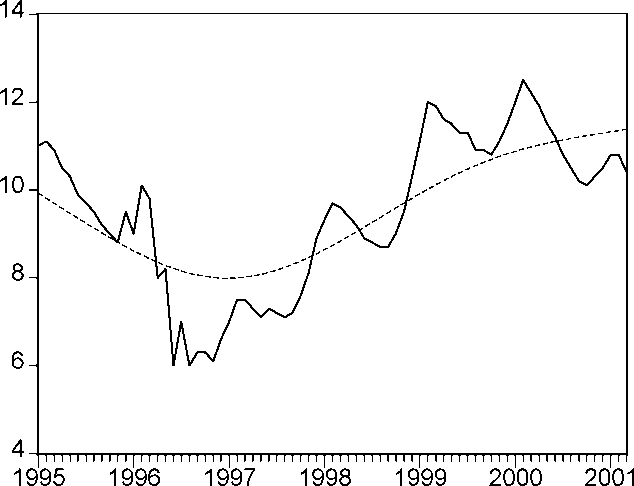William Davidson Institute Working Paper 402

---Unemployment rate ------Trend
Figure 3. Unemployment rate, actual and trend (Hodrick and Prescott filter). January
1995 to March 2001. Source: NBR Monthly Statistical Bulletins
It is also worth mentioning that the Romanian current account balance was in
deficit throughout this period; it reached 7.4% of GDP in 1998 before the financial
crisis, fell to 3.8% of GDP following the balance of payments adjustment of 1999,
and stayed around 4% of GDP in 2000. In early 2001 it started to grow again
worryingly as output picked up. This large external imbalance is a signal of poor
competitiveness of Romanian exports, and perhaps of an overvalued national currency
(in real terms).
Clearly Romania has had major difficulties in achieving successful macro-
stabilisation. All through the nineties, when all other Central and Eastern European
countries made significant progress in this respect, the situation in Romania stalled.
How to explain this outcome? It is well known that there are fundamental
relationships between the microeconomic structure of the economy, the institutions at
work and the macroeconomic performances, but such a theory of comprehensive
reform is beyond the scope of this study. We only comment on the role that the
monetary and exchange rate mechanisms could have in improving the macroeconomic
performance.
6. The Romanian banking system
A two-tier banking system was implemented in Romania at the end of 1990,
made up of a central bank (the National Bank of Romania - NBR) and the credit
institutions (or ordinary banks).
6.1 Ordinary banks and the credit market
Many of credit institutions which exist today took over the incumbent
networks, already in operation under the central plan period. The most important
network builds on the former local branches of the central bank itself; other networks
come from the more specialized financial institutions, like the national investment
12
More intriguing information
1. The name is absent2. Der Einfluß der Direktdemokratie auf die Sozialpolitik
3. Towards a framework for critical citizenship education
4. From Communication to Presence: Cognition, Emotions and Culture towards the Ultimate Communicative Experience. Festschrift in honor of Luigi Anolli
5. Multifunctionality of Agriculture: An Inquiry Into the Complementarity Between Landscape Preservation and Food Security
6. Ongoing Emergence: A Core Concept in Epigenetic Robotics
7. The name is absent
8. WP 48 - Population ageing in the Netherlands: Demographic and financial arguments for a balanced approach
9. Linking Indigenous Social Capital to a Global Economy
10. Has Competition in the Japanese Banking Sector Improved?